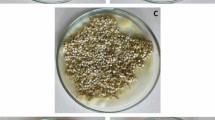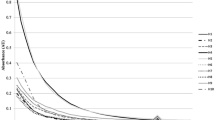Abstract
We have investigated the effect of cultivation systems and fruit post-harvest management on the antioxidant properties of apricot fruits. Trees of five cultivars ‘Tyrinthos’, ‘Cafona’, ‘Bella d’Italia’, ‘Vitillo’ and ‘Pellecchiella’ were cultivated under integrated and organic systems. Fruits were collected at full maturity stage and analyzed either immediately or after storage at 4±0.5 °C and 85% of relative humidity for seven and 14 days. The main pomological traits (weight, colour, flesh firmness, total soluble sugars, titratable acidity) and antioxidant properties were analyzed. The total antioxidant capacity (TAC by TEAC method), total phenols content (TP by Folin-Ciocalteu method) and carotenoid content by HPLC-DAD were monitored. Cultivar characterization by principal component analysis (PCA) indicated a large variability on pomological and antioxidant properties of apricot fruits. ‘Bella d’Italia’ showed better TAC and TP values compared to the other cultivars. ANOVA interactions between cultivar and cultivation system (organic/integrated) were found for the antioxidant properties. These interactions may help to select a set of genotypes with better performances under organic system, which in our study might be indicated in ‘Cafona’ and ‘Bella d’Italia’.




Similar content being viewed by others
References
Kaur C, Kapoor HC (2001) Antioxidants in fruits and vegetables—the millennium’s health. Int J Food Sci Technol 36:703–725
Tomas-Barberan FA, Espin JC (2001) Phenolic compounds and related enzymes as determinants of quality in fruits and vegetables. J Sci Food Agric 81:853–876
Garcia-Alonso M, de Pascual-Teresa S, Santos-Buelga C, Rivas-Gonzalo JC (2004) Evaluation of the antioxidant properties of fruits. Food Chem 84:13–18
Yao LH, Jiang YM, Shi J, Tomas-Barberan FA, Datta N, Singanusong R, Chen SS (2004) Flavonoids in food and their health benefits. Plant Foods Hum Nutr 59:113–122
Chinnici F, Bendini A, Gaiani A, Riponi C (2004) Radical scavenging activities of peels and pulps from cv. Golden Delicious apples as related to their phenolic composition. J Agric Food Chem 52:4684–4689
Veberic R, Trobec M, Herbinger K, Hofer M, Grill D, Stampar F (2005) Phenolic compounds in some apple (Malus domestica Borkh) cultivars of organic and integrated production. J Sci Food Agric 85:1687–1694
Hecke K, Herbinger K, Veberic R, Trobec M, Toplak H, Stampar F, Keppel H, Grill D (2006) Sugar-, acid- and phenol contents in apple cultivars from organic and integrated fruit cultivation. Eur J Clin Nutr 60:1136–1140
Briviba K, Stracke BA, Rufer CE, Watzl B, Weibel FP, Bub A (2007) Effect of consumption of organically and conventionally produced apples on antioxidant activity and DNA damage in humans. J Agric Food Chem 55:7716–7721
Carbonaro M, Mattera M (2001) Polyphenoloxidase activity and polyphenol levels in organically and conventionally grown peach (Prunus persica L., cv. Regina Bianca) and pear (Pyrus communis L., cv. Williams). Food Chem 72:419–424
Lombardi-Boccia G, Lucarini M, Lanzi S, Aguzzi A, Cappelloni M (2004) Nutrients and antioxidant molecules in yellow plums (Prunus domestica L.) from conventional and organic productions: a comparative study. J Agric Food Chem 52:90–94
Benge JR, Tillman R, Nihal De Silva H (2000) Pairwaise comparison of the storage potential of kiwifruit from organic and conventional production systems. New Zealand J Crop Hort Sci 28:147–152
Amodio ML, Colelli G, Hasey JK, Kader AA (2007) A comparative study of composition and postharvest performance of organically and conventionally grown kiwifruits. J Sci Food Agric 87:1228–1236
Asami DK, Hong Y-J, Barrett DM, Mitchell AE (2003) Comparison of the total phenolic and ascorbic acid content of freeze-dried and air-dried marionberry, strawberry, and corn grown using conventional, organic, and sustainable agricultural practices. J Agric Food Chem 51:1237–1241
Caris-Veyrat C, Amiot M-J, Tyssander V, Grasselly D, Buret M, Mikolajczak M, Borel P (2004) Influence of organic versus conventional agricultural practice on the antioxidant microconstituent content of tomatoes and derived purees, consequences on antioxidant plasma status in humans. J Agric Food Chem 52:6503–6509
Lester GE (2006) Organic versus conventionally grown produce: qualitative differences, and guidelines for comparison studies. HortScience 41:296–300
Woese K, Lange D, Boess C, Bogl KW (1997) A comparison of organically and conventionally grown foods. Results of a review of the relevant literature. J Sci Food Agric 74:281–293
Audergon JM, Giard A, Lambert P, Blanc A, Gilles F, Signoret V, Richard JC, Albagnac G, Bureau S, Gouble B, Grotte M, Reich M, Legave JM, Clauzel G, Dicenta F, Scortichini M, Simeone AM, Guerriero R, Viti R, Monteleone P, Bartolini S, Martins JMS, Tsiantos J, Psallidas P (2006) Optimization of apricot breeding by a joint conventional and molecular approach applied to the main agronomic traits—ABRIGEN Project. Acta Hort 701:317–320
Lichou J, Jay M, Vaysse P, Lespinasse N (2003) Reconnaitre les variétés d’abricots. Ctifl, Paris, France, pp 17–29
Parker RS (1996) Carotenoids. 4. Absorption, metabolism and transport of carotenoid. FASEB J 10:542–551
Nishino H, Murakoshi M, Tokuda H, Satomi Y (2009) Cancer prevention by carotenoids. Arch Biochem Biophys 483:165–168
Shaish A, Harari A, Kamari Y, Soudant E, Harats D, Ben-Amotz A (2008) A carotenoid algal preparation containing phytoene and phytofluene inhibited LDL oxidation in vitro. Plant Food Hum Nutr 63:83–86
Curl AL (1960) The carotenoids of apricots. Food Res 24:190–196
Radi M, Mahrouz M, Jaouad A (1997) Phenolic content, browning susceptibility and carotenoid content of several apricot cultivars at maturity. HortScience 32:1087–1091
Sass-Kiss A, Kiss J, Milotay P, Kerek MM, Toth-Markus M (2005) Differences in anthocyanin and carotenoid content of fruits and vegetables. Food Res Int 38:1023–1029
Fraser PD, Bramely PM (2004) The biosynthesis and nutritional uses of carotenoids. Prog Lipid Res 43:228–265
Munzuroglu O, Karatas F, Gecki H (2003) The vitamin and selenium contents of apricot fruit of different varieties cultivated in different geographical regions. Food Chem 83:205–212
Ruiz D, Egea J, Tomas-Barberan FA, Gil MI (2005) Carotenoids from new apricot (Prunus armeniaca L.) varieties and their relationship with flesh and skin colour. J Agric Food Chem 53:6368–6374
Dragovic-Uzelac V, Levaj B, Mrkic V, Bursac D, Boras M (2007) The content of polyphenols and carotenoids in three apricot cultivars depending on the stage of maturity and geographical origin. Food Chem 102:966–975
Scalzo J, Politi A, Pellegrini N, Mezzetti B, Battino M (2005) Plant genotype affects total antioxidant capacity and phenolic contents in fruit. Nutrition 21:207–213
Bartolini S, Viti R, Zanol GC (2006) Apricot cultivars and cold storage affect total antioxidant capacity and glutathione content in fruit. Acta Hort 717:359–362
Leccese A, Bartolini S, Viti R (2008) Total antioxidant capacity and phenolics content in fresh apricots. Acta Alim 37:65–76
Silva BM, Andrade PB, Martins RC, Valentao P, Ferreres F, Seabra RM, Ferreira MA (2005) Quince (Cydonia oblonga Miller) fruit characterization using principal component analysis. J Agric Food Chem 53:111–122
Cantin CM, Gogorcena Y, Moreno MA (2010) Phenotypic diversity and relationships of fruit quality traits in peach and nectarine [Prunus persica (L.) Batsch] breeding progenies. Euphytica 171:221–226
Ruiz D, Egea J (2008) Phenotypic diversity and relationship of fruit quality traits in apricot (Prunus armeniaca L.) germplasm. Euphytica 163:143–158
Arts MJTJ, Dallinga JS, Voss HP, Haenen GRMM, Bast A (2004) A new approach to assess the total antioxidant capacity using the TEAC assay. Food Chem 88:567–570
Waterhouse AL (2001) Determination of total phenolics. In John Wiley & Sons Eds. Current Protocols in Food Analytical Chemistry, New York, USA, c. I1.1.1–I1.1.8
Wright KP, Kader AA (1997) Effect of controlled-atmosphere storage on the quality and carotenoid content of sliced persimmons and peaches. Postharvest Biol Technol 10:89–97
Mattatelli B, Persiani A, La Certosa G, Dichio B, Celano G (2002) La coltura dell’albicocco in Basilicata: tecniche produttive e destinazioni industriali. Frutticultura 3:41–55
Marty I, Bureau S, Sarkissian G, Gouble B, Audergon JM, Albagnac G (2005) Ethylene regulation of carotenoid accumulation and carotenogenic gene expression in colour-contrasted apricot varieties (Prunus armeniaca). J Exp Bot 56:1877–1886
Kalt W, Forney CF, Martin A, Prior RL (1999) Antioxidant capacity, vitamin C, phenolics and anthocyanins after fresh storage of small fruit. J Agric Food Chem 47:4638–4644
Kim D, Jeong SW, Lee CY (2003) Antioxidant capacity of phenolic phytochemicals from various cultivars of plums. Food Chem 81:321–326
Acknowledgement
Thanks to Philip Schiff from the Department of Physics and Astronomy, Stony Brook University (United States) for the English revision of the text and his helpful comments.
Author information
Authors and Affiliations
Corresponding author
Rights and permissions
About this article
Cite this article
Leccese, A., Bureau, S., Reich, M. et al. Pomological and Nutraceutical Properties in Apricot Fruit: Cultivation Systems and Cold Storage Fruit Management. Plant Foods Hum Nutr 65, 112–120 (2010). https://doi.org/10.1007/s11130-010-0158-4
Published:
Issue Date:
DOI: https://doi.org/10.1007/s11130-010-0158-4




